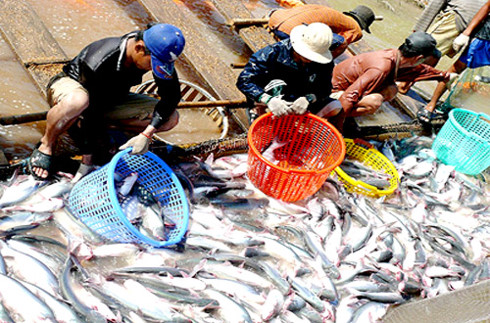|
Agriculture
industry aims for US$40 billion export target
Agroforestry and seafood exports set a new trade record of US$36.37
billion in 2017, a rise of more than US$4 billion over the previous year and
setting new milestones in the process, however, last year also brought losses
in the pig-farming industry and the EU’s issuance of a yellow card to
Vietnamese seafood.

Fruit, vegetables, seafood and forestry products yield
impressive growth
Exports
of fruit and vegetables soared by 40.5% to US$3.45 billion last year with the
four largest importers being China Japan the US, and the Republic of Korea.
In addition to the traditional markets, the gradual increase in quality of
Vietnamese fruit has enabled it to conquer demanding markets such as the US,
EU, Japan, Canada, Australia, and New Zealand.
Nguyen
Huu Dat, Secretary General of the Vietnam Fruit and Vegetable Association,
says that following the momentum of growth in recent years, fruit and
vegetables have spearheaded the rise in exports of agricultural products,
surpassing even the traditional strongholds of rice and oil and gas.
Mr
Dat attributes the result to the exhaustive efforts of relevant agencies in
diversifying markets and stimulating exports.
Almost
a year ago, shipments of cashew nuts were forecast to grow beyond the US$3
billion mark for the first time in 2017. In reality, they outperformed
expectations by swelling to US$3.52 billion, with 353,000 tonnes of the nuts
exported by the end of 2017, a rise of 23.8% in value and 1.9% in volume. The
average price of raw cashews increased by 22.3% against the previous year.
The
US, Netherlands, and China remained the three largest consumers of Vietnamese
cashew nuts with market shares of 35%, 15.6%, and 12.9%, respectively.
The
past decade has seen Vietnam edge ever closer to establishing itself as the
world’s main cashew processing hub with the country leapfrogging India to become
the primary cashew nut processor. Vietnam now processes 1.6-1.7 million
tonnes out of the total global volume of 3.4 million tonnes of raw cashews
every year. It holds the advantage of specialization when it comes to
producing the most delicious cashew nuts in the world. Recently, many
countries have imported advanced processing machines and technologies from
Vietnam but processing factories in Africa have been unable to reproduce the
quality and efficiency of Vietnam’s products.
The
forestry and seafood sectors made astonishing progress after setting new
records by both reaching US$8 billion in export value.. Forestry exports grew
9.1% to US$8 billion with the three largest consumers being the US, China,
and Correspondingly, seafood exports surged up by 18% to US$8.32 billion with
the four biggest importers being the US, Japan, China, and the ROK accounting
for 55.3% of total export value.
Last
year also provided a rebound for many agricultural products such as rice,
coffee, rubber, cassava, and tea, however, they did not rally to the record
levels they set several years ago. Conversely, last year saw the pig-farming
industry wallow into crisis and a decline in the pepper and coffee sectors.
Pepper exports rose by 20.5% to a volume of 214,000 tonnes but shrunk 21.9%
in value to US$1.12 billion while coffee exports slumped, falling 20.2% in
volume to 1.42 million tonnes and 3.8% in value to US$3.12 billion with the
two biggest consumers- Germany and the US.
Vietnam
has so far exported nearly 200 different farm products abroad.
The
livestock industry is currently in the most unfavourable position among key
agricultural industries. The country’s pork production was estimated at
2.75 million tonnes last year, ranking sixth in the world after China, the
EU, the US, Brazil, and Russia.
Most
of the pork products were exported to China via unofficial channels. In 2016,
nearly 12 million pigs were sold to China via such unofficial channels but in
2017 the channel was blocked, plunging the pig-farming industry into crisis.
As a result, supply exceeded demand and prices tumbled, subjecting farmers to
more than eighteen months of continual setbacks.
Some
experts say significant breakthroughs have not seen in exports of different
kinds of Vietnamese meat over the years.
In
another unfavourable move, on October 23, 2017 the European Commission (EC)
issued a "yellow card" warning to Vietnam, after the country failed
to demonstrate sufficient progress in its fight against illegal, unreported,
and unregulated (IUU) fishing worldwide. At present, seafood exports are
proceeding as usual. But a yellow card could result in 100% of shipments from
Vietnam to the EU undergoing strict checks, driving up the costs of storage
and inspections. It could also undermine the confidence of importers in other
markets.
Hitting US$40 billion target this year
The
Ministry of Agriculture and Rural Development (MARD) has to resolve pending
issues to ensure the fulfillment of the targeted US$40 billion export value
this year. Firstly, greater efforts must be made to overturn the EU yellow
card for seafood exports.
It
is imperative to fine-tune its management institutions, oversee fishing
fleets in sustainably exploiting aquaculture resources, revamp the system to
monitor and supervise fishing vessels at sea and in ports, certify the origin
of seafood materials, and eliminate illegal fishing in foreign waters. The
Law on Fisheries which has come into effect must be swiftly put into practise
in order to ensure that fishing activities are in line with EU and
international regulations.
At
the MARD’s review conference for 2017, Prime Minister Nguyen Xuan Phuc called
for greater efforts to elevate agricultural exports target to US$40 billion
this year. If weaknesses are remedied and advantages are fully exploited, the
target will be achievable, he said.
VOV
|
Thứ Bảy, 24 tháng 2, 2018
Đăng ký:
Đăng Nhận xét (Atom)
Không có nhận xét nào:
Đăng nhận xét